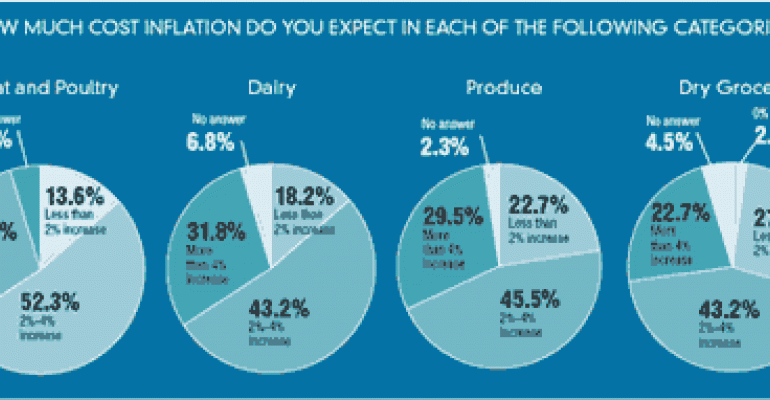Supermarkets will face more food-cost inflation in 2008 than they did in 2007, and the increases will be difficult for many operators to pass on to their customers, according to a survey conducted last month by SN.
For the most part, food retailers in their recent earnings calls have indicated that they have been able to pass their cost increases along to their customers in the form of higher retail prices, but nearly 80% of respondents to SN’s online survey said they expect rising food costs to impact their margins to some degree in 2008.
The weak economy and rising food costs are dealing a one-two punch to consumers, but so far food retailers have been able to withstand the whirlwind as consumers have been willing to dig deeper into their wallets and more of them seem to be curtailing restaurant spending in favor of at-home dining. But with some analysts projecting continued sharp food-cost increases, and with gas prices expected to spike to new highs this summer, consumers could be under more pressure than they have been in decades to tighten their grocery budgets.
“It is an interesting time in the food industry — consumers are challenged by a slow economy and higher energy prices,” said Ephraim Leibtag, an economist with the U.S. Department of Agriculture Economic Research Service, Washington, who studies retail food prices and the dynamics of food markets. “We have experienced this in the past, but it has been a while. The big question is whether there is a way out in the short term, or will it be longer term.
“It remains to be seen how long the economic slowdown will last, and whether or not the slowing economy will prevent retailers from passing on high costs,” he said. “Where does the buck stop? Who is paying and who is not?”
After food inflation of 4% in 2007, analysts are predicting a similar increase in 2008. Some reports have suggested that food inflation could be even higher this year and could be long-lasting, while others have said they expect food costs to moderate by the end of the year.
Chuck Cerankosky, an analyst with FTN Midwest Securities, Cleveland, said he believes consumers may be cutting back in other areas, which may have the impact of freeing up their grocery budgets.

“Inflation is hitting all aspects of consumers’ lives, not only food and fuel, but utility bills, the cost of automobiles, and other things, so people are going to make an incredible variety of spending decisions based on what they view as their economic position,” he said. “That might mean spending even more at a supermarket because they are deciding they are not eating out nearly as much as they have been, or they may cancel a vacation, or they may opt out of buying a new car. The trading down and other decisions that are made in a wobbly economy are not just going to be made within the confines of the grocery store.”
Whether supermarkets pass through their cost increases could vary by market, he pointed out, with some retailers in highly competitive areas keeping prices low to retain market share.
“But at the end of the day, higher operating costs that all retailers share need to get passed along, or the business just cannot operate profitably,” he noted.
Ayuna Kidder, an economist at TNS Retail Forward, Columbus, Ohio, said in general she expects retailers to be more promotional on price during economic downturns.
According to that company’s February ShopperScape survey on household spending, rising food prices have begun to change consumer behavior. More than half (51%) of all shoppers are not buying food items that seem “just too expensive,” the survey found, and 43% of all shoppers said they are dining out less to save money. More than one-third (39%) of all shoppers are cutting food budgets by making more frequent use of coupons, and 37% are “simply spending less overall.”
In SN’s survey, 52.3% of respondents said they planned to conduct “a little more” price-focused advertising this year than last year, while another 38.6% said they would not increase such promotional activity.
Some retailers have noted in recent earnings calls that they have begun to see consumers trading down to lower-priced products, such as substituting chicken for beef and choosing private-label products rather than name brands. In SN’s survey, 86.4% of respondents said they believe consumers have been doing some substitution, although most of those — 50% of the total — said trading down has been limited to “a few products here and there.”
Some retailers in recent presentations to analysts and investors said they have not witnessed this phenomenon at all. In the survey, 11.4% of respondents said they had seen no trading down by consumers.
According to a report on CPG prices from Information Resources Inc., Chicago, consumers began to shift their purchases toward more private-label product last year and could continue to do so this year, depending on whether inflation moderates.
In the 10 categories tracked by IRI that had the largest price increases in 2007, consumers either bought less or shifted more of their spending to Wal-Mart or private label. IRI noted that frozen poultry was an exception, where demand increased despite price hikes.
The 10 categories with the highest price increases, according to IRI data, were fresh eggs, up 30.3%; frozen poultry, 20.2%; refrigerated juices, 14.5%; milk, 12%; bakery snacks, 11%; baby formula, 10%; coffee, 7.9%; skin care, 7.6%; and cat food, 6.5%.





